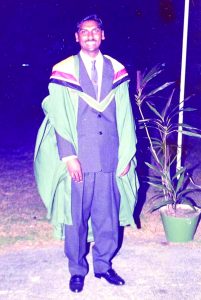By Vishani Ragobeer
WHEN one thinks of the public health sector in Guyana, at least in more recent memory, Dr. Shamdeo Persaud is a name that is all-too-familiar. He has been on your screens, adding a face to the pertinent COVID-19 updates, and behind the scenes getting crafting guidelines for safe health practices.
Dr. Shamdeo is the outgoing Chief Medical Officer (CMO); he has served in this capacity since 2007, and has given about three decades of his life to serving and improving the public health sector.
He was the last of 11 children, born 55 years ago, to today’s date (October 18), in fact. After doing well at his ‘A’ level examinations, where he was keenly interested in science and mathematics, studying medicine seemed to be the obvious choice. He went into Guyana’s National Service and taught for a year before securing a Public Service Scholarship to go abroad and study. At that time, however, the University of Guyana (UG) just established its medical programme and instead of going overseas, the young Shamdeo stayed in Guyana and became part of the first batch of UG-trained doctors, five years later in 1990.
CHOLERA OUTBREAK
After graduating, he had to work as an intern for two years before starting his five-year contract at the Georgetown Public Hospital. In 1992, while working in anesthesiology, he was sent to the North-West District in Region One to help with the massive cholera outbreak that started in Peru before making its way across South America.
Cholera is an infectious, waterborne disease which causes severe watery diarrhea which can lead to dehydration and even death, if untreated. Those riverain communities in Region were particularly vulnerable given their sanitation and hygiene woes. Dr. Shamdeo was out in the field, travelling in the boats, across communities, trying to control this outbreak.
“The need for public health really struck me, you know, working with communities and going out there,” Dr. Shamdeo told the Pepperpot. “I appreciated the importance of public health programmes, like the vaccination programmes, and what struck me too was the number of persons who had conditions that treatments and interventions were available for, but not available to them.”
So striking was this experience that the young Dr. Shamdeo stayed in this Region as the Regional Health Officer (RHO). As the fight against cholera waged on, he also took up additional responsibilities of planning and coordination medical services and activities for the region of about 24, 000 people. And all the while, he did so along with two medexes and one other doctor in the region.
TB & FILARIASIS

Eventually, he came back from Mabaruma, and was placed in Guyana’s ‘TB’ programme. Tuberculosis, or TB, is an infectious disease caused by a type of bacteria, which affects the lungs and can spread to other parts of the body. He recalled that Guyana did not have a huge TB problem, but with the advent of the HIV (a virus that attacks cells that help the body fight infection), at the end of the 80s and early 90s, persons could be even more vulnerable to TB.
He recalled being placed in the TB programme “to really boost it” and half-laughed that it almost felt like that was another outbreak, at that time.
A few years later, then came the focus on Lymphatic Filariasis, and he was the programme manager for that initiative. This is a disease that affects the body’s lymphatic system, which functions to remove unwanted fluids from the body and transports ‘lymph’– a fluid which contains white bloods cells that helps to fight infections. It causes elephantiasis (or “big foot”) or hydrocele (or “goadie”).
“As we were tackling this, we got into all this social medicine- learning social marketing as a tool, developing health promotion and education initiatives (and) distributing the fortified salt,” he related. Then, he really garnered the importance of providing wider health benefits when crafting an health programme.
As part of the filaria elimination programme, persons were expected to use diethylcarbamazine (DEC)?medicated salt (or “DEC salt”). However, after discussions with other health sectors, a triple-benefit salt was crafted which included iodine and fluoride. It was not just about fighting filaria, then; it was also about adding iodine to the diet of Guyanese and fluoride for better dental health.
2005 FLOOD
Now, by this time you can imagine that Dr. Shamdeo was really ‘in the thick of things’ but evidently not ‘out of his depth’. He also served, intermittently, in disease control and decided to pursue a Master’s Degree in Epidemiology, in Jamaica at the University of the West Indies (UWI). It wasn’t long after that the infamous 2005 flood struck Guyana and Dr. Persaud was tapped to serve as the Director of Communicable Diseases- which essentially meant that he led the (medical) charge against the waters.
There was an outbreak of leptospirosis, a bacterial infection, caused by the contact of exposed human skin (through cuts and lesions) with the waters contaminated with the urine of rats.
“We had converted the whole ministry to respond to that effort,” he recalled. The personnel department of the Ministry was converted to a pharmacy, medical response teams were formed and the prevention programme for leptospirosis started. After the rat-urine situation was detected, emphasis was placed on treating skin wounds and teaching people how to clean up after coming into contact with the contaminated water.
“The outbreaks are a really important part of my career progression,” Dr. Shamdeo added, with a chuckle.
2007 CRICKET WORLD CUP
Then came the 2007 Cricket World Cup, in Guyana and other parts of the Caribbean. It wasn’t an outbreak of a certain disease, but boy oh boy, did it require the same effort. Dr. Shamdeo explained that there are numerous risks associated with the mass gathering of people, and health services had to be prepared to deal with any eventuality.
The games went smoothly, unless of course you count the West Indies inability to make it to the semi-finals- and the then Chief Medical Officer, Dr. Rudolph Cummings went on to work with CARICOM. Coming to the crease was the ace batsman, Dr. Shamdeo Persaud, who managed to anchor the innings, until now.
When asked what made him the man for the job, he nervously laughed. His ability to anchor the Guyana Public Health team was evident, but he was too modest to admit.
However, he did say that he developed a good relationship with all of his colleagues, whether they practised in the public or private sector, and his relationships were heavily based on respect. Having played many high-intensity matches before, he was confident that he had the ability, as well. In the stands, he had his large family- his wife, three children and 10 older siblings (six sisters and four brothers) supporting him even when things got turbulent.
“We work in a very complex environment, balancing between technical persons but also with principals who are politicians and you have to balance that equation very delicately as CMO,” he said, speaking about the demands of the job. “There were some rough moments… but what I always try to do is put people first in this equation.”
Putting persons first is how he got through his career, really. As CMO, there were heightened concerns for the H1N1 (swine flu) pandemic Chikungunya, Zika and even Ebola. Maternal deaths were also a concern, and one of those health issues which really hit the CMO. Crafting guidelines and protocols, or coordinating services were all integral parts of his job, but he could never divorce the human interest aspect.
“Nevermind if they are five or six children with a (type of) cancer, you might say that’s a small number, but to the family, and to that child, that the most important thing- that’s the largest thing to them,” he said, emphasising again that it was not about the statistics but it was about real people.
COVID-19
Of course, this summary of Dr. Shamdeo’s work thus far would be incomplete without mention of the current pandemic caused by the novel coronavirus, COVID-19. At the end of last year, this was flagged as an emerging problem in China, and while preparation was underway across the globe, who really knew what devastation it would eventually bring?
At the beginning of January, Dr. Shamdeo finally used some of his long-accumulated leave to attend a few family engagements, out of Guyana. For him, personally, that was the calm before the storm.
As soon as he returned to Guyana, in mid-January, he went straight to the Woodlands hospital, where there was a potential case of COVID-19. He recalled meeting with the team, who weren’t quite sure what to do, save for keeping the person isolated. And, Guyana did not yet have testing capacity, so the samples had to be shipped abroad.
From then, the preparation intensified- getting the ports of entry prepared, drafting guidelines and protocols, procuring protective equipment and the whole works. Then on March 11, Guyana had its first case which, according to Dr. Shamdeo, did not start off on the “right foot” as the woman lost her life, unfortunately. Eventually, seeing the need for someone the person can look towards for credible information, he became the face of the daily briefings.
“I was eager to get the message over and no deaths to report was always the thing we kept our fingers crossed for. We hoped for a low number of cases each day,” he said. The CMO also explained that striking the balance between providing credible information but not “overloading” persons was vital.
Now, the pandemic is still a long way from being over and Guyana still has to catch up on the time and concern lost to the infamous 2020 election. The country will not be doing so with its long standing CMO, who has reached the age of retirement and will be leaving his post.
“The task is still a big one,” he said. While he believes that he left the health sector even if just a tiny bit better than it was before, he knows that there is much more to be done. Dr. Shamdeo highlighted that he will be focusing on the more private aspects of his life, but like the true trooper he is, he remains ready to serve Guyana’s public sector once called upon.




.png)









